Competitive Strategy, HR Theories, and AI: A Tesco Case Study Analysis
VerifiedAdded on 2023/06/10
|7
|1985
|137
Essay
AI Summary
This essay provides a comprehensive analysis of Tesco's business strategy, focusing on its competitive advantage and human resource management practices. It begins with an introduction to the changing global business environment and the opportunities presented by digitalization, using Tesco as a case study. The main body of the essay explores competitive strategy models, particularly Porter's Five Forces, to assess Tesco's position in the retail industry. It then delves into various HR theories, including the standard causal model of HRM, the Fombrun, Tichy and Devanna theory, and the Guest Model, examining their relevance to Tesco's workforce management. Key aspects of HR such as talent acquisition, learning and development, and change management are also discussed in the context of Tesco's operations and its response to the COVID-19 pandemic. The essay concludes by summarizing the importance of competitive strategies, employee management, and the role of HR models in achieving business objectives in a dynamic environment. The essay highlights how Tesco leverages technology and adapts to market changes to maintain a competitive edge.
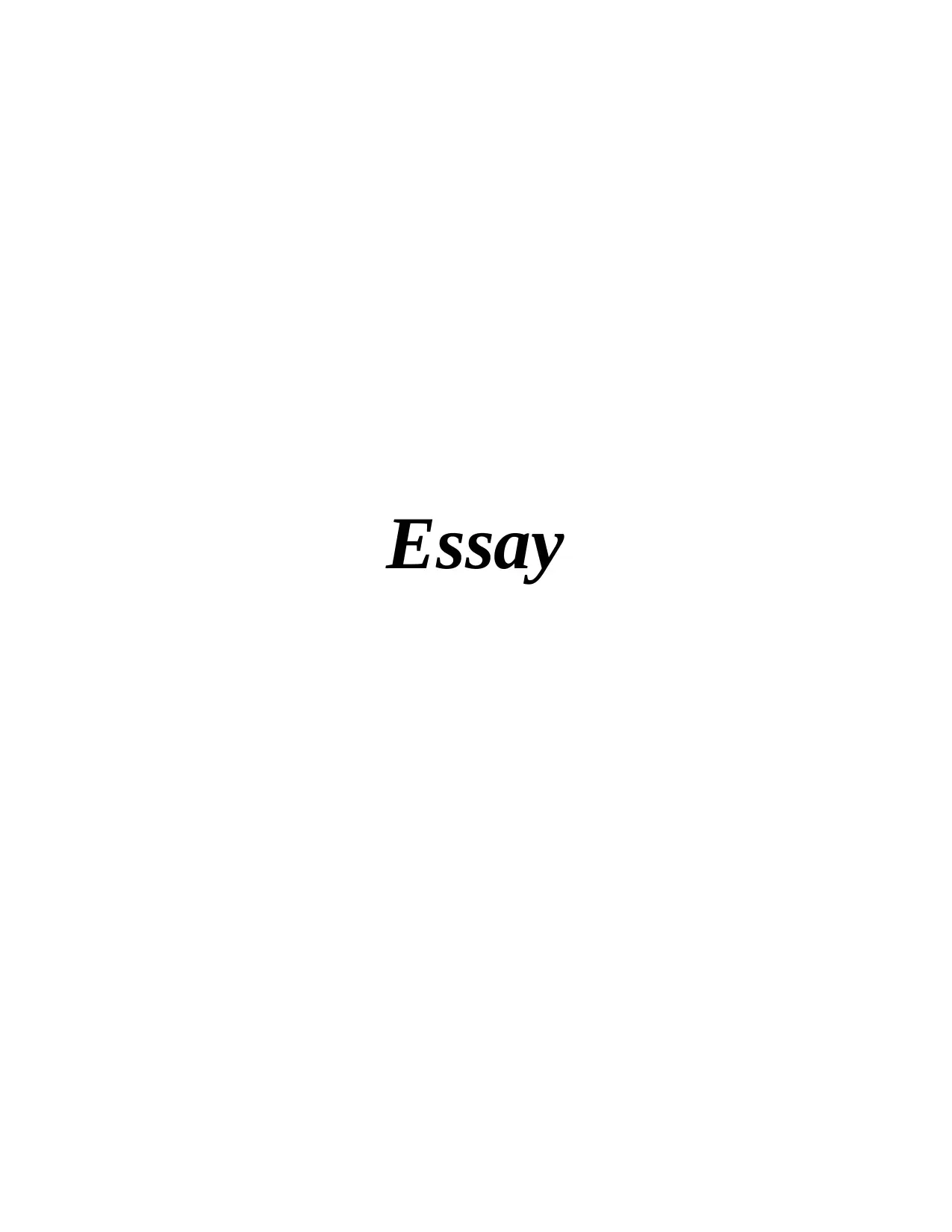
Essay
Paraphrase This Document
Need a fresh take? Get an instant paraphrase of this document with our AI Paraphraser
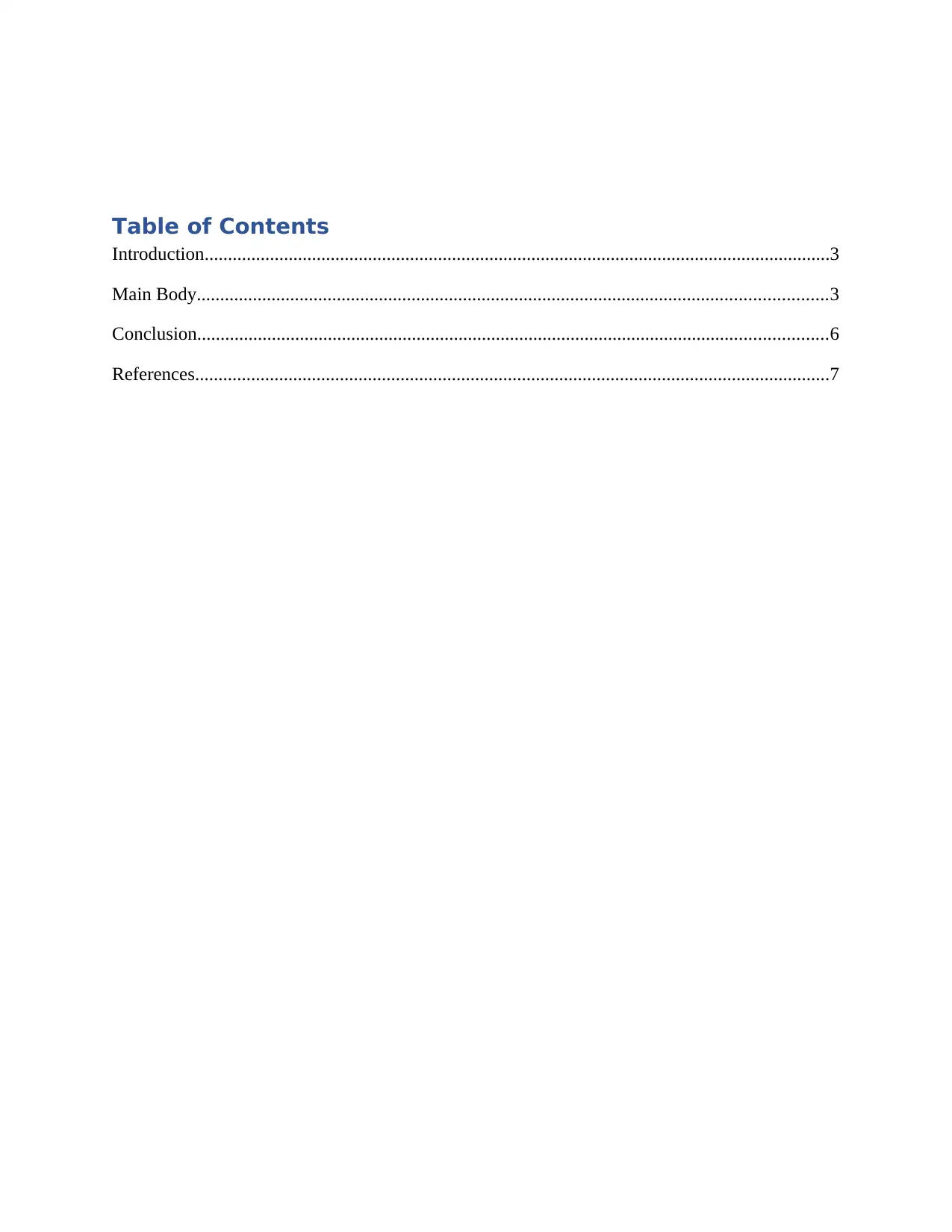
Table of Contents
Introduction......................................................................................................................................3
Main Body.......................................................................................................................................3
Conclusion.......................................................................................................................................6
References........................................................................................................................................7
Introduction......................................................................................................................................3
Main Body.......................................................................................................................................3
Conclusion.......................................................................................................................................6
References........................................................................................................................................7
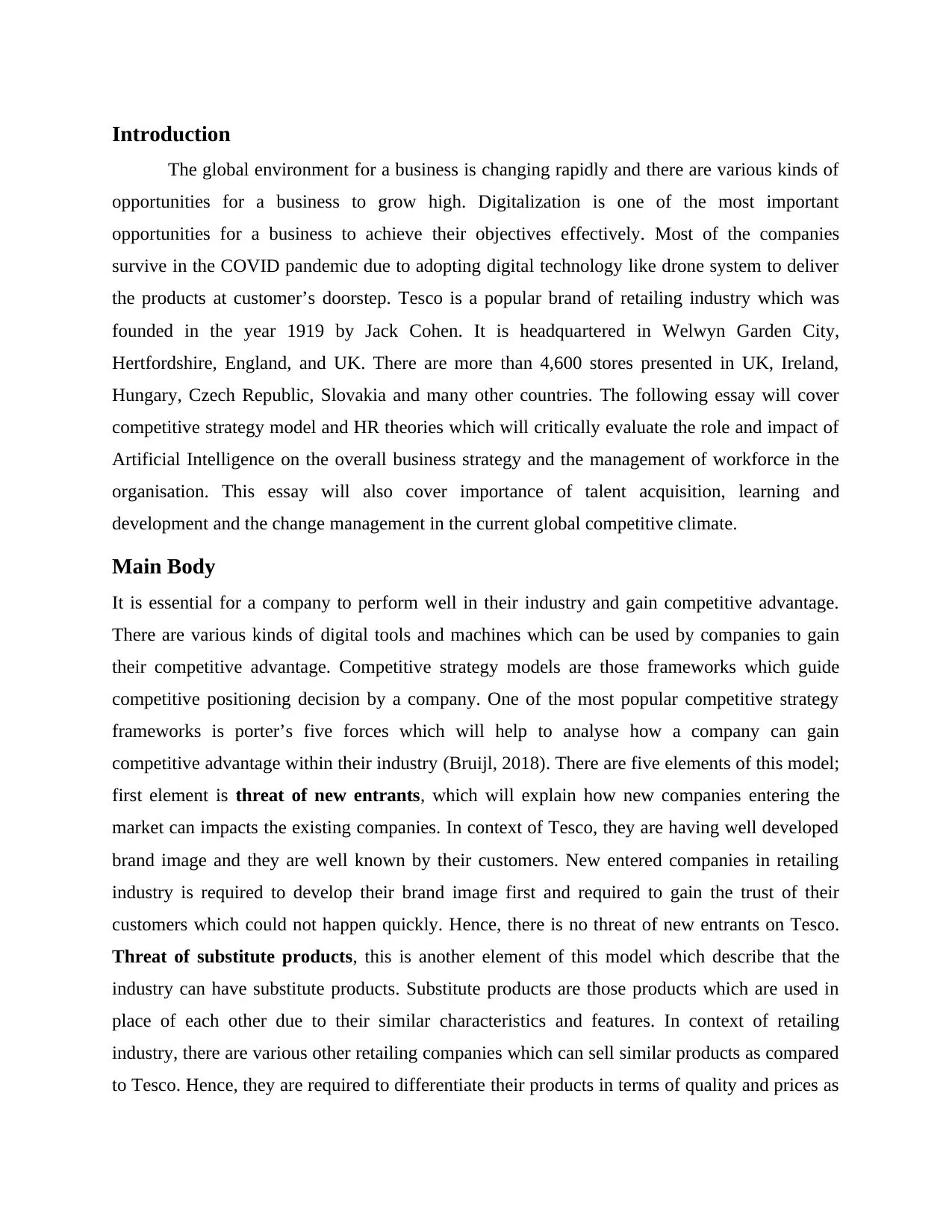
Introduction
The global environment for a business is changing rapidly and there are various kinds of
opportunities for a business to grow high. Digitalization is one of the most important
opportunities for a business to achieve their objectives effectively. Most of the companies
survive in the COVID pandemic due to adopting digital technology like drone system to deliver
the products at customer’s doorstep. Tesco is a popular brand of retailing industry which was
founded in the year 1919 by Jack Cohen. It is headquartered in Welwyn Garden City,
Hertfordshire, England, and UK. There are more than 4,600 stores presented in UK, Ireland,
Hungary, Czech Republic, Slovakia and many other countries. The following essay will cover
competitive strategy model and HR theories which will critically evaluate the role and impact of
Artificial Intelligence on the overall business strategy and the management of workforce in the
organisation. This essay will also cover importance of talent acquisition, learning and
development and the change management in the current global competitive climate.
Main Body
It is essential for a company to perform well in their industry and gain competitive advantage.
There are various kinds of digital tools and machines which can be used by companies to gain
their competitive advantage. Competitive strategy models are those frameworks which guide
competitive positioning decision by a company. One of the most popular competitive strategy
frameworks is porter’s five forces which will help to analyse how a company can gain
competitive advantage within their industry (Bruijl, 2018). There are five elements of this model;
first element is threat of new entrants, which will explain how new companies entering the
market can impacts the existing companies. In context of Tesco, they are having well developed
brand image and they are well known by their customers. New entered companies in retailing
industry is required to develop their brand image first and required to gain the trust of their
customers which could not happen quickly. Hence, there is no threat of new entrants on Tesco.
Threat of substitute products, this is another element of this model which describe that the
industry can have substitute products. Substitute products are those products which are used in
place of each other due to their similar characteristics and features. In context of retailing
industry, there are various other retailing companies which can sell similar products as compared
to Tesco. Hence, they are required to differentiate their products in terms of quality and prices as
The global environment for a business is changing rapidly and there are various kinds of
opportunities for a business to grow high. Digitalization is one of the most important
opportunities for a business to achieve their objectives effectively. Most of the companies
survive in the COVID pandemic due to adopting digital technology like drone system to deliver
the products at customer’s doorstep. Tesco is a popular brand of retailing industry which was
founded in the year 1919 by Jack Cohen. It is headquartered in Welwyn Garden City,
Hertfordshire, England, and UK. There are more than 4,600 stores presented in UK, Ireland,
Hungary, Czech Republic, Slovakia and many other countries. The following essay will cover
competitive strategy model and HR theories which will critically evaluate the role and impact of
Artificial Intelligence on the overall business strategy and the management of workforce in the
organisation. This essay will also cover importance of talent acquisition, learning and
development and the change management in the current global competitive climate.
Main Body
It is essential for a company to perform well in their industry and gain competitive advantage.
There are various kinds of digital tools and machines which can be used by companies to gain
their competitive advantage. Competitive strategy models are those frameworks which guide
competitive positioning decision by a company. One of the most popular competitive strategy
frameworks is porter’s five forces which will help to analyse how a company can gain
competitive advantage within their industry (Bruijl, 2018). There are five elements of this model;
first element is threat of new entrants, which will explain how new companies entering the
market can impacts the existing companies. In context of Tesco, they are having well developed
brand image and they are well known by their customers. New entered companies in retailing
industry is required to develop their brand image first and required to gain the trust of their
customers which could not happen quickly. Hence, there is no threat of new entrants on Tesco.
Threat of substitute products, this is another element of this model which describe that the
industry can have substitute products. Substitute products are those products which are used in
place of each other due to their similar characteristics and features. In context of retailing
industry, there are various other retailing companies which can sell similar products as compared
to Tesco. Hence, they are required to differentiate their products in terms of quality and prices as
⊘ This is a preview!⊘
Do you want full access?
Subscribe today to unlock all pages.

Trusted by 1+ million students worldwide
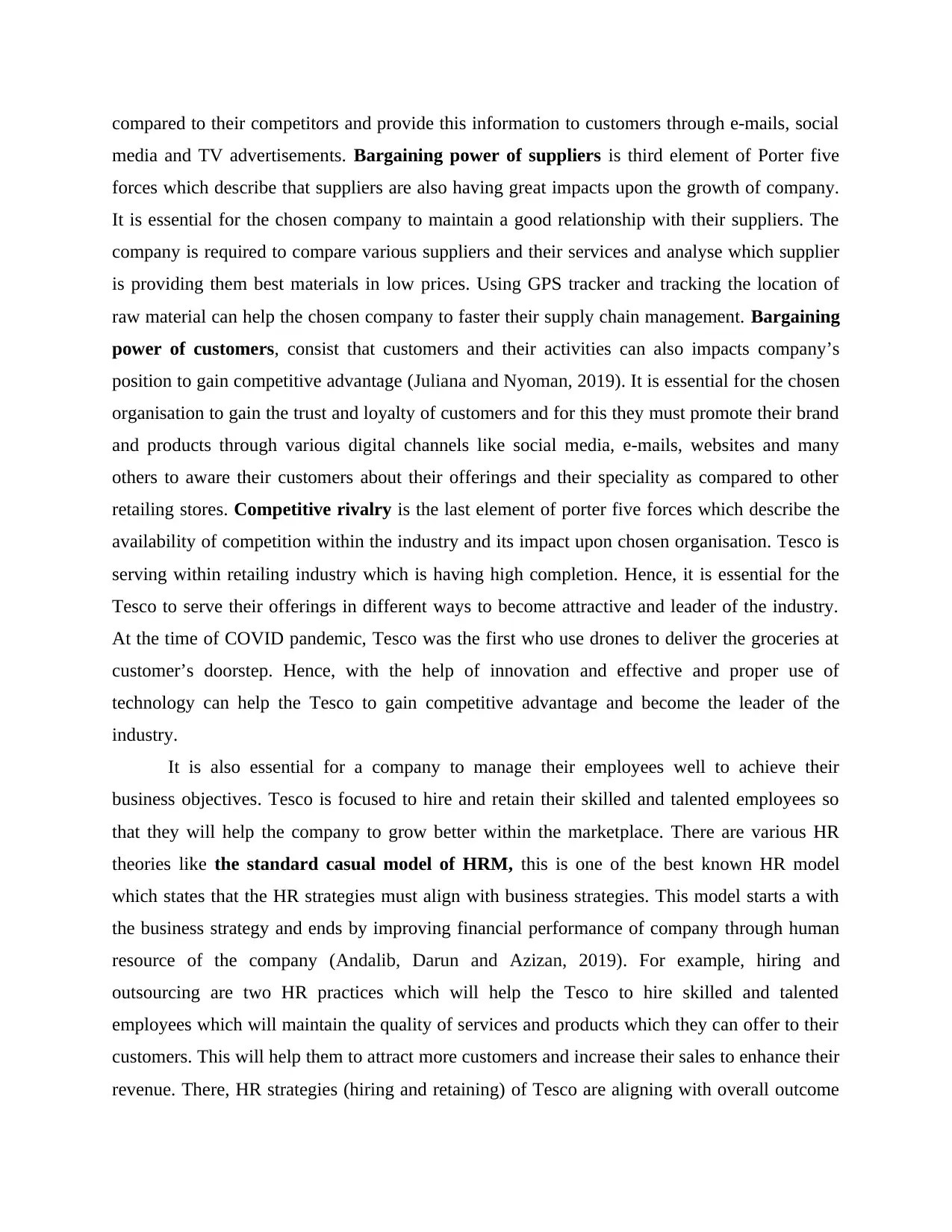
compared to their competitors and provide this information to customers through e-mails, social
media and TV advertisements. Bargaining power of suppliers is third element of Porter five
forces which describe that suppliers are also having great impacts upon the growth of company.
It is essential for the chosen company to maintain a good relationship with their suppliers. The
company is required to compare various suppliers and their services and analyse which supplier
is providing them best materials in low prices. Using GPS tracker and tracking the location of
raw material can help the chosen company to faster their supply chain management. Bargaining
power of customers, consist that customers and their activities can also impacts company’s
position to gain competitive advantage (Juliana and Nyoman, 2019). It is essential for the chosen
organisation to gain the trust and loyalty of customers and for this they must promote their brand
and products through various digital channels like social media, e-mails, websites and many
others to aware their customers about their offerings and their speciality as compared to other
retailing stores. Competitive rivalry is the last element of porter five forces which describe the
availability of competition within the industry and its impact upon chosen organisation. Tesco is
serving within retailing industry which is having high completion. Hence, it is essential for the
Tesco to serve their offerings in different ways to become attractive and leader of the industry.
At the time of COVID pandemic, Tesco was the first who use drones to deliver the groceries at
customer’s doorstep. Hence, with the help of innovation and effective and proper use of
technology can help the Tesco to gain competitive advantage and become the leader of the
industry.
It is also essential for a company to manage their employees well to achieve their
business objectives. Tesco is focused to hire and retain their skilled and talented employees so
that they will help the company to grow better within the marketplace. There are various HR
theories like the standard casual model of HRM, this is one of the best known HR model
which states that the HR strategies must align with business strategies. This model starts a with
the business strategy and ends by improving financial performance of company through human
resource of the company (Andalib, Darun and Azizan, 2019). For example, hiring and
outsourcing are two HR practices which will help the Tesco to hire skilled and talented
employees which will maintain the quality of services and products which they can offer to their
customers. This will help them to attract more customers and increase their sales to enhance their
revenue. There, HR strategies (hiring and retaining) of Tesco are aligning with overall outcome
media and TV advertisements. Bargaining power of suppliers is third element of Porter five
forces which describe that suppliers are also having great impacts upon the growth of company.
It is essential for the chosen company to maintain a good relationship with their suppliers. The
company is required to compare various suppliers and their services and analyse which supplier
is providing them best materials in low prices. Using GPS tracker and tracking the location of
raw material can help the chosen company to faster their supply chain management. Bargaining
power of customers, consist that customers and their activities can also impacts company’s
position to gain competitive advantage (Juliana and Nyoman, 2019). It is essential for the chosen
organisation to gain the trust and loyalty of customers and for this they must promote their brand
and products through various digital channels like social media, e-mails, websites and many
others to aware their customers about their offerings and their speciality as compared to other
retailing stores. Competitive rivalry is the last element of porter five forces which describe the
availability of competition within the industry and its impact upon chosen organisation. Tesco is
serving within retailing industry which is having high completion. Hence, it is essential for the
Tesco to serve their offerings in different ways to become attractive and leader of the industry.
At the time of COVID pandemic, Tesco was the first who use drones to deliver the groceries at
customer’s doorstep. Hence, with the help of innovation and effective and proper use of
technology can help the Tesco to gain competitive advantage and become the leader of the
industry.
It is also essential for a company to manage their employees well to achieve their
business objectives. Tesco is focused to hire and retain their skilled and talented employees so
that they will help the company to grow better within the marketplace. There are various HR
theories like the standard casual model of HRM, this is one of the best known HR model
which states that the HR strategies must align with business strategies. This model starts a with
the business strategy and ends by improving financial performance of company through human
resource of the company (Andalib, Darun and Azizan, 2019). For example, hiring and
outsourcing are two HR practices which will help the Tesco to hire skilled and talented
employees which will maintain the quality of services and products which they can offer to their
customers. This will help them to attract more customers and increase their sales to enhance their
revenue. There, HR strategies (hiring and retaining) of Tesco are aligning with overall outcome
Paraphrase This Document
Need a fresh take? Get an instant paraphrase of this document with our AI Paraphraser
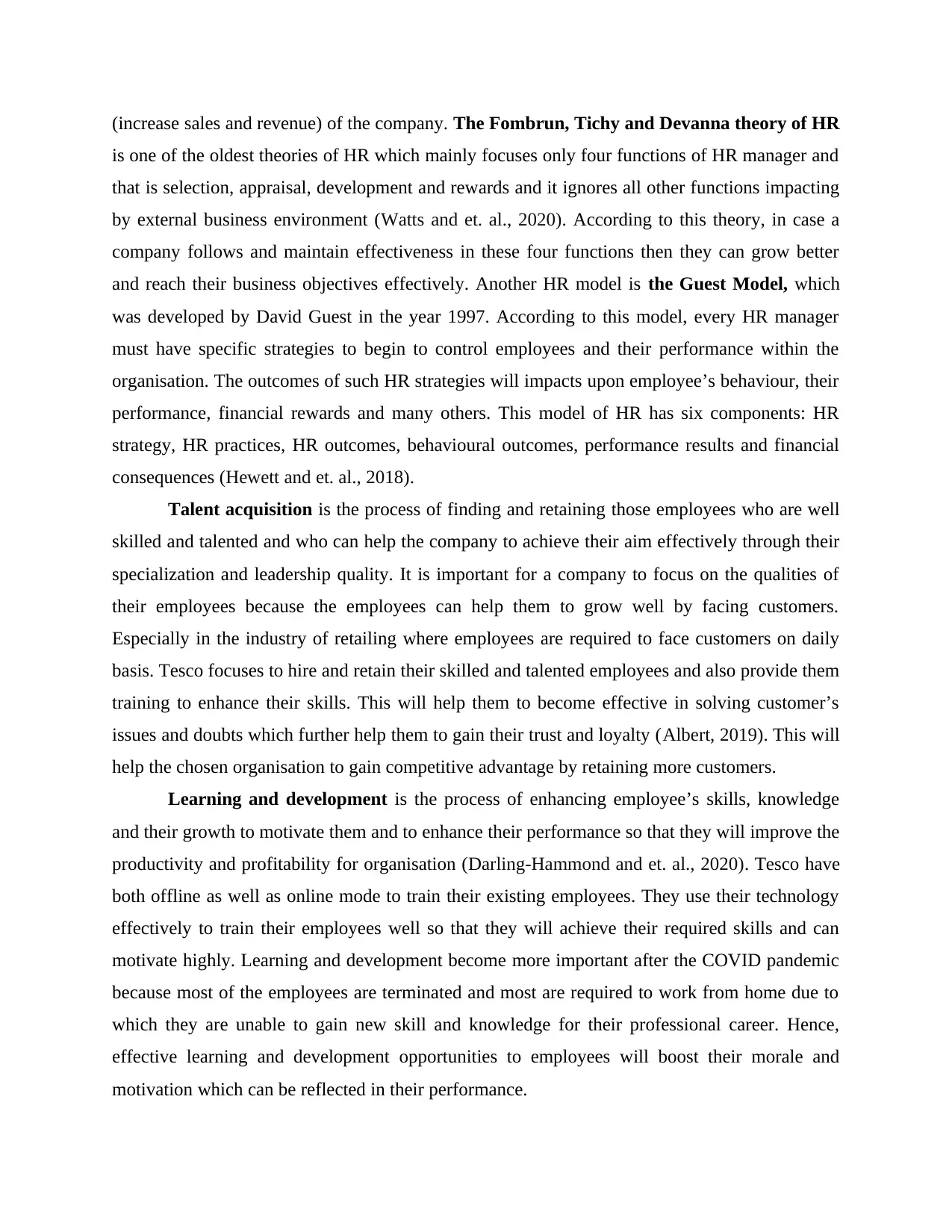
(increase sales and revenue) of the company. The Fombrun, Tichy and Devanna theory of HR
is one of the oldest theories of HR which mainly focuses only four functions of HR manager and
that is selection, appraisal, development and rewards and it ignores all other functions impacting
by external business environment (Watts and et. al., 2020). According to this theory, in case a
company follows and maintain effectiveness in these four functions then they can grow better
and reach their business objectives effectively. Another HR model is the Guest Model, which
was developed by David Guest in the year 1997. According to this model, every HR manager
must have specific strategies to begin to control employees and their performance within the
organisation. The outcomes of such HR strategies will impacts upon employee’s behaviour, their
performance, financial rewards and many others. This model of HR has six components: HR
strategy, HR practices, HR outcomes, behavioural outcomes, performance results and financial
consequences (Hewett and et. al., 2018).
Talent acquisition is the process of finding and retaining those employees who are well
skilled and talented and who can help the company to achieve their aim effectively through their
specialization and leadership quality. It is important for a company to focus on the qualities of
their employees because the employees can help them to grow well by facing customers.
Especially in the industry of retailing where employees are required to face customers on daily
basis. Tesco focuses to hire and retain their skilled and talented employees and also provide them
training to enhance their skills. This will help them to become effective in solving customer’s
issues and doubts which further help them to gain their trust and loyalty (Albert, 2019). This will
help the chosen organisation to gain competitive advantage by retaining more customers.
Learning and development is the process of enhancing employee’s skills, knowledge
and their growth to motivate them and to enhance their performance so that they will improve the
productivity and profitability for organisation (Darling-Hammond and et. al., 2020). Tesco have
both offline as well as online mode to train their existing employees. They use their technology
effectively to train their employees well so that they will achieve their required skills and can
motivate highly. Learning and development become more important after the COVID pandemic
because most of the employees are terminated and most are required to work from home due to
which they are unable to gain new skill and knowledge for their professional career. Hence,
effective learning and development opportunities to employees will boost their morale and
motivation which can be reflected in their performance.
is one of the oldest theories of HR which mainly focuses only four functions of HR manager and
that is selection, appraisal, development and rewards and it ignores all other functions impacting
by external business environment (Watts and et. al., 2020). According to this theory, in case a
company follows and maintain effectiveness in these four functions then they can grow better
and reach their business objectives effectively. Another HR model is the Guest Model, which
was developed by David Guest in the year 1997. According to this model, every HR manager
must have specific strategies to begin to control employees and their performance within the
organisation. The outcomes of such HR strategies will impacts upon employee’s behaviour, their
performance, financial rewards and many others. This model of HR has six components: HR
strategy, HR practices, HR outcomes, behavioural outcomes, performance results and financial
consequences (Hewett and et. al., 2018).
Talent acquisition is the process of finding and retaining those employees who are well
skilled and talented and who can help the company to achieve their aim effectively through their
specialization and leadership quality. It is important for a company to focus on the qualities of
their employees because the employees can help them to grow well by facing customers.
Especially in the industry of retailing where employees are required to face customers on daily
basis. Tesco focuses to hire and retain their skilled and talented employees and also provide them
training to enhance their skills. This will help them to become effective in solving customer’s
issues and doubts which further help them to gain their trust and loyalty (Albert, 2019). This will
help the chosen organisation to gain competitive advantage by retaining more customers.
Learning and development is the process of enhancing employee’s skills, knowledge
and their growth to motivate them and to enhance their performance so that they will improve the
productivity and profitability for organisation (Darling-Hammond and et. al., 2020). Tesco have
both offline as well as online mode to train their existing employees. They use their technology
effectively to train their employees well so that they will achieve their required skills and can
motivate highly. Learning and development become more important after the COVID pandemic
because most of the employees are terminated and most are required to work from home due to
which they are unable to gain new skill and knowledge for their professional career. Hence,
effective learning and development opportunities to employees will boost their morale and
motivation which can be reflected in their performance.
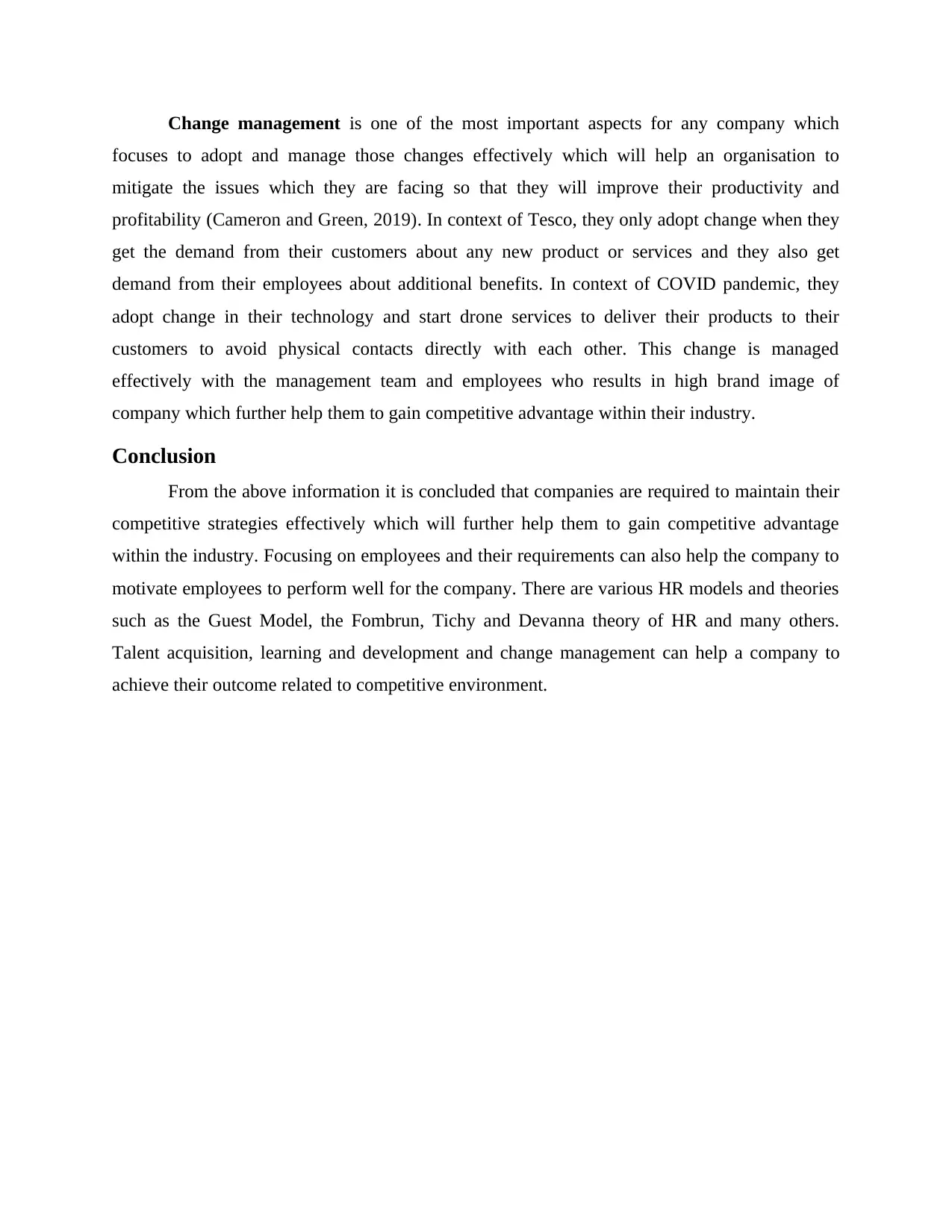
Change management is one of the most important aspects for any company which
focuses to adopt and manage those changes effectively which will help an organisation to
mitigate the issues which they are facing so that they will improve their productivity and
profitability (Cameron and Green, 2019). In context of Tesco, they only adopt change when they
get the demand from their customers about any new product or services and they also get
demand from their employees about additional benefits. In context of COVID pandemic, they
adopt change in their technology and start drone services to deliver their products to their
customers to avoid physical contacts directly with each other. This change is managed
effectively with the management team and employees who results in high brand image of
company which further help them to gain competitive advantage within their industry.
Conclusion
From the above information it is concluded that companies are required to maintain their
competitive strategies effectively which will further help them to gain competitive advantage
within the industry. Focusing on employees and their requirements can also help the company to
motivate employees to perform well for the company. There are various HR models and theories
such as the Guest Model, the Fombrun, Tichy and Devanna theory of HR and many others.
Talent acquisition, learning and development and change management can help a company to
achieve their outcome related to competitive environment.
focuses to adopt and manage those changes effectively which will help an organisation to
mitigate the issues which they are facing so that they will improve their productivity and
profitability (Cameron and Green, 2019). In context of Tesco, they only adopt change when they
get the demand from their customers about any new product or services and they also get
demand from their employees about additional benefits. In context of COVID pandemic, they
adopt change in their technology and start drone services to deliver their products to their
customers to avoid physical contacts directly with each other. This change is managed
effectively with the management team and employees who results in high brand image of
company which further help them to gain competitive advantage within their industry.
Conclusion
From the above information it is concluded that companies are required to maintain their
competitive strategies effectively which will further help them to gain competitive advantage
within the industry. Focusing on employees and their requirements can also help the company to
motivate employees to perform well for the company. There are various HR models and theories
such as the Guest Model, the Fombrun, Tichy and Devanna theory of HR and many others.
Talent acquisition, learning and development and change management can help a company to
achieve their outcome related to competitive environment.
⊘ This is a preview!⊘
Do you want full access?
Subscribe today to unlock all pages.

Trusted by 1+ million students worldwide
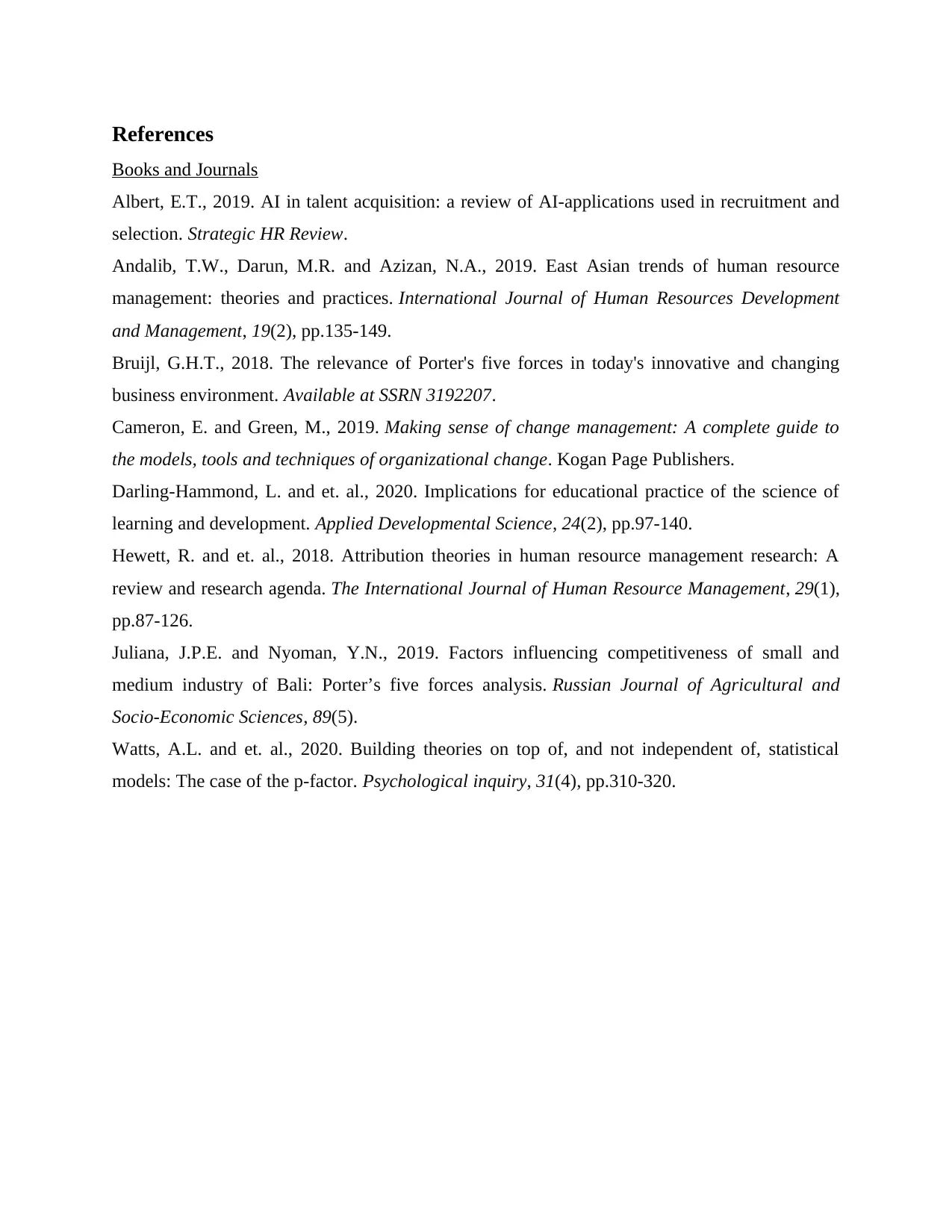
References
Books and Journals
Albert, E.T., 2019. AI in talent acquisition: a review of AI-applications used in recruitment and
selection. Strategic HR Review.
Andalib, T.W., Darun, M.R. and Azizan, N.A., 2019. East Asian trends of human resource
management: theories and practices. International Journal of Human Resources Development
and Management, 19(2), pp.135-149.
Bruijl, G.H.T., 2018. The relevance of Porter's five forces in today's innovative and changing
business environment. Available at SSRN 3192207.
Cameron, E. and Green, M., 2019. Making sense of change management: A complete guide to
the models, tools and techniques of organizational change. Kogan Page Publishers.
Darling-Hammond, L. and et. al., 2020. Implications for educational practice of the science of
learning and development. Applied Developmental Science, 24(2), pp.97-140.
Hewett, R. and et. al., 2018. Attribution theories in human resource management research: A
review and research agenda. The International Journal of Human Resource Management, 29(1),
pp.87-126.
Juliana, J.P.E. and Nyoman, Y.N., 2019. Factors influencing competitiveness of small and
medium industry of Bali: Porter’s five forces analysis. Russian Journal of Agricultural and
Socio-Economic Sciences, 89(5).
Watts, A.L. and et. al., 2020. Building theories on top of, and not independent of, statistical
models: The case of the p-factor. Psychological inquiry, 31(4), pp.310-320.
Books and Journals
Albert, E.T., 2019. AI in talent acquisition: a review of AI-applications used in recruitment and
selection. Strategic HR Review.
Andalib, T.W., Darun, M.R. and Azizan, N.A., 2019. East Asian trends of human resource
management: theories and practices. International Journal of Human Resources Development
and Management, 19(2), pp.135-149.
Bruijl, G.H.T., 2018. The relevance of Porter's five forces in today's innovative and changing
business environment. Available at SSRN 3192207.
Cameron, E. and Green, M., 2019. Making sense of change management: A complete guide to
the models, tools and techniques of organizational change. Kogan Page Publishers.
Darling-Hammond, L. and et. al., 2020. Implications for educational practice of the science of
learning and development. Applied Developmental Science, 24(2), pp.97-140.
Hewett, R. and et. al., 2018. Attribution theories in human resource management research: A
review and research agenda. The International Journal of Human Resource Management, 29(1),
pp.87-126.
Juliana, J.P.E. and Nyoman, Y.N., 2019. Factors influencing competitiveness of small and
medium industry of Bali: Porter’s five forces analysis. Russian Journal of Agricultural and
Socio-Economic Sciences, 89(5).
Watts, A.L. and et. al., 2020. Building theories on top of, and not independent of, statistical
models: The case of the p-factor. Psychological inquiry, 31(4), pp.310-320.
1 out of 7
Related Documents
Your All-in-One AI-Powered Toolkit for Academic Success.
+13062052269
info@desklib.com
Available 24*7 on WhatsApp / Email
![[object Object]](/_next/static/media/star-bottom.7253800d.svg)
Unlock your academic potential
Copyright © 2020–2025 A2Z Services. All Rights Reserved. Developed and managed by ZUCOL.




